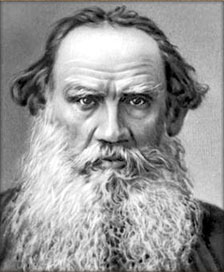Afanasy Fet, in a January 1, 1870, letter to Tolstoy, expressed his great delight with the novel. “You’ve managed to show us in great detail the other, mundane side of life and explain how organically does it feed the outer, heroic side of it”, he added.
Ivan Turgenev gradually re-considered his initial skepticism as to the novel’s historical aspect and also the style of Tolstoy’s psychological analysis. In his 1880 article written in the form of a letter addressed to Edmond Abou, the editor of the French newspaper Le XIXe Siècle, Turgenev described Tolstoy as “the most popular Russian writer” and War and Peace as “one of the most remarkable books of our age.” “This vast work has the spirit of an epic, where the life of Russia of the beginning of our century in general and in details has been recreated by the hand of a true master …
The manner in which Count Tolstoy conducts his treatise is innovative and original. This is the great work of a great writer, and in it there’s true, real Russia,” Turgenev wrote. It was largely due to Turgenev’s efforts that the novel started to gain popularity with the European readership. The first French edition of the War and Peace (1879) paved the way for the worldwide success of Leo Tolstoy and his works.
Since then many world-famous authors have praised War and Peace as a masterpiece of world literature. Gustave Flaubert expressed his delight in a January 1880 letter to Turgenev, writing: “This is the first class work! What an artist and what a psychologist! The first two volumes are exquisite. I used to utter shrieks of delight while reading. This is powerful, very powerful indeed.”
Later John Galsworthy called War and Peace “the best novel that had ever been written”. Romain Rolland, remembering his reading the novel as a student, wrote, “This work, like life itself, has no beginning, no end. It is life itself in its eternal movement.” Thomas Mann thought War and Peace to be “the greatest ever war novel in the history of literature.”[35] When Virginia Woolf finished the book, she declared “There remains the greatest of all novelists—for what else can we call the author of War and Peace?”
Ernest Hemingway confessed that it was from Tolstoy that he had been taking lessons on how to “write about war in the most straightforward, honest, objective and stark way.” “I don’t know anybody who could write about war better than Tolstoy did”, Hemingway asserted in his 1955 Men at War. The Best War Stories of All Time anthology.
Isaac Babel said, after reading War and Peace, “If the world could write by itself, it would write like Tolstoy.” Tolstoy “gives us a unique combination of the ‘naive objectivity’ of the oral narrator with the interest in detail characteristic of realism. This is the reason for our trust in his presentation.”
English translations
War and Peace has been translated into many languages. It has been translated into English on several occasions, starting with Clara Bell working from a French translation. The translators Constance Garnett and Aylmer and Louise Maude knew Tolstoy personally. Translations have to deal with Tolstoy’s often peculiar syntax and his fondness for repetitions. Only about two percent of War and Peace is in French; Tolstoy removed the French in a revised 1873 edition, only to restore it later. Most translators follow Garnett retaining some French; Briggs and Shubin use no French, while Pevear–Volokhonsky’s and Amy Mandelker’s revisions of the Maude translation both retain the French fully.
Film
The first Russian adaptation was Война и мир (Voyna i mir) in 1915, which was directed by Vladimir Gardin and starred Gardin and the Russian ballerina Vera Karalli.
Fumio Kamei produced a version in Japan: War and Peace (戦争と平和 Sensō to heiwa) (1947)
The 208-minute-long American 1956 version was directed by King Vidor and starred Audrey Hepburn (Natasha), Henry Fonda (Pierre) and Mel Ferrer (Andrei). Audrey Hepburn was nominated for a BAFTA Award for best British actress and for a Golden Globe Award for best actress in a drama production.
The critically acclaimed, four-part and 431-minutes long Soviet War and Peace, by director Sergei Bondarchuk, was released in 1966 and 1967. It starred Ludmila Savelyeva (as Natasha Rostova) and Vyacheslav Tikhonov (as Andrei Bolkonsky). It won an Oscar for Best Foreign Language Film for its authenticity and massive scale.[citation needed] It attracted some controversy due to the number of horses killed during the making of the battle sequences and screenings were actively boycotted in several US cities by the ASPCA.
